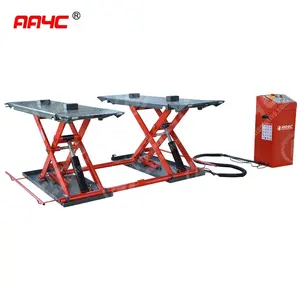












A car ramp lift, sometimes called a car lift or automotive lift, raises automobiles. The vehicles must be lifted for upkeep, repairs, inspections, or storage. The mechanics don't have to crawl underneath a car for maintenance and repairs if they use car lift ramps. Hence, they become essential to auto repair shops, garages, and even home workshops.
A typical car lift ramp is the scissor lift. The word "scissor" describes it because of the multiple crossed metal supports upon which it is constructed. Hydraulic fluid pressure is another way that the vehicle is commonly raised. As a result, they are referred to as hydraulic car lift ramps. They are renowned for their capacity to grow objects steadily and deliberately, which offers stability when doing maintenance duties. Hydraulic lifts come in two varieties: 2 post car lifts and 4 post car lift ramps. Reaching the center is easy with two-post models because they raise the vehicle from either side. In contrast, four-post models—frequently employed for extended raises—use four vertical posts to create a sturdy lifting platform. The users may also find portable car ramp lifts useful. They are helpful when a single lift needs to service several locations or for on-the-go repairs.
Improved accessibility is one of the main advantages since a car lift for garage offers a quick and easy way to raise an automobile to a comfortable working height. This accessibility makes it simpler for mechanics and auto enthusiasts to do inspections and repairs. It also serves safety and health benefits. With the car raised at a certain height, people working underneath the vehicle can operate more comfortably and with less physical strain. This reduces the possibility of accidents caused by awkward postures or small areas. Time efficiency is another benefit users should know about. When the mechanics raise the car, tasks can be completed more quickly and efficiently. This time savings can be significant for commercial auto repair shops, where business operations depend on workflow optimization and downtime minimization. Car ramps are safer than conventional jack stands. Their slow incline makes the vehicle's platform more stable, which lowers the possibility of mishaps or instability when performing maintenance. The increased stability improves worker safety for those underneath the car.
Car ramps are frequently built from various materials to make vehicle access and maintenance easier. High-density polyethylene (HDPE) is commonly used to make car ramps. Its sturdy, lightweight construction, made possible by the long-lasting plastic, makes it simple to handle and transport. Another standard option is metal car ramps constructed of steel or aluminum. Steel ramps are renowned for being strong and long-lasting, and aluminum ramps are corrosion-resistant. There are also the less common wooden car ramp lifts. A wooden car ramp is frequently used in DIY projects.